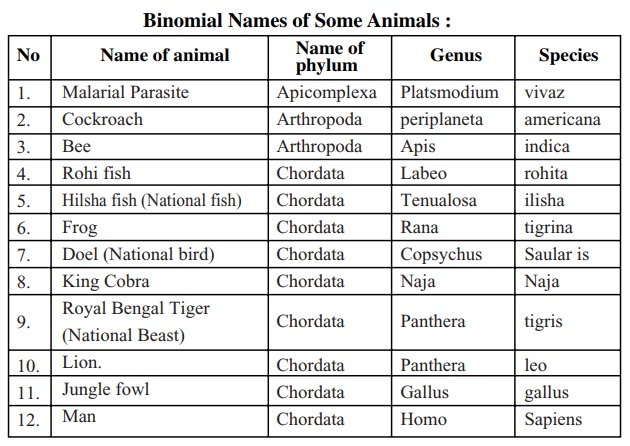Chapter: Biology: Animal Diversity and Classification
Rules for Modern or Natural Classification in Animal Diversity
RULES FOR MODERN OR NATURAL CLASSIFICATION
1. Kingdom, Phylum, Class, Order, Family, Genus and Species names are to be written one below the other in definite order.
2. Names of the step can be written either in English or in BangIa. But the Phylum name must be written in English, e.g. in the case of writing the classification of man. Man is a.n animal of the phylum Chordate. Here at the time of writing, general name of the taxon can be written in English or in BangIa but the Phylum name chordata must be written in Roman alphabet never to be written in BangIa.
3. When writing in hands, in both the cases of plants and animals, the generic and specific names must be underlined individually. For example, in case of Man when writing in hand, Genus: Homo, Species: Homo sapiens. This can also be written as H.sapiens:
4. When printed Genus and species names are to be printed in italics. as: Genus: Homo and Species: Homo sapiens, H sapiens ..
5. Excepting the generic and species names, no other taxon should not be underlined.
6. For the name of family of all animals there should be an ending of four letters 'idae', such as: Hominidae (family of human) Bufonidae (family of toad).
7. In case of invertebrate animals, it is enough to write seven taxonomic categories in English, namely kingdom, Phylum, Class, Order, Family, Genus and Species. But in case of the vertebrate animals like Man, Frog, Snake Fish etc. you are to write the taxon subphylum, under ,the phylum chordata. For example the classification of Man and Toad are given below.
a. Classification of Man
Kingdom Animalia
Phylum Chordata
Subphylum Vertebrata
Class Mammalia
Order Anthropoidea
Family Hominidae
Genus Homo
Specie H. sapiens
Kingdom - Animalia
Phylum - Chordata
Sub-phylum - Vertebrate
Class - Amphibia
Order - Salientia
Family - Bufonidae
Genus - Bufo
Species- B. melanostictus
N. B. In case ofveliebrate animals like Toad. Man etc, you are to write in totalof eight taxa including sub phylum vertebrata.
8. You must write in full the scientific or species name of any animal, such as scientific name of toad: in print you are to write Bufo melanostictus but while classifying species names can be printed both as B. melanostictus or Bufo melanostictus and in hand B. melanostictus. But it never can be printed melanostictus or written melanostictus.
9. Scientific name is to be written in combination of two parts. Of these two parts, the first one is the genus part of the scientific name and the other is the species part, e. g. scientific ,name of Toad is Bufo melanostictus. Here Bufo is the genus part and melanosticutus is the species part. This system of naming the animals was approved by the ICZN (International commission on Zoological Nomenclature) in 1961.
So, the process of scientific naming of organisms (plants and animals) with the combination of two words using the genus name first and species name thereafter is called Binomial Nomenclature.

Like animals, unicellular organisms were placed into phylum protozoa. But now they are separated from the animal kingdom and placed in protista or protoctista of 5-kingdom classification. However, as phylum protozoa were a part of the animal kingdom, previously therefore they are still taught in zoology. In the last decade, about the 80's, the International Protozoologist Committee decided that the unicellular protozoans are of vast variety and that they should be included in a single phylum. Thus they have classified protozoans under 7 phyla. In this classification, protozoa is a subkingdom of protista or protoctista kingdom. Among them the amoeba is included in-the phylum Sarcomastigophorea and malarial parasite is in Apicomplexa. The names of nine major phyla of animal kingdom are mentioned below with their
Related Topics